Abstract
We conducted a phase III study to test the hypothesis that initial therapy with “lower dose” prednisone is effective and safe for patients with newly diagnosed acute graft-versus-host disease. We hypothesized that a 50% decrease in the initial dose of prednisone for treatment of acute graft-versus-host disease would suffice to control graft-versus-host disease without increasing the incidence of secondary treatment. Patients with grade IIa manifestations (upper gastrointestinal symptoms, stool volumes <1.0 L/day, rash involving <50% of the body surface, no hepatic dysfunction; n=102) were randomized to start treatment with prednisone at 1 mg/kg/day or 0.5 mg/kg/day. Those with grade IIb or higher manifestations (rash involving ≥50% of the body surface, stool volumes ≥1.0 L/day or hepatic involvement; n=62) were randomized to start treatment with prednisone at 2 mg/kg/day or 1 mg/kg/day. The primary study end point (a ≥33% relative reduction of the mean cumulative prednisone dose by day 42 after initial treatment with lower dose prednisone) was not reached. With a median follow up of 36 months (range 7–53), initial treatment with lower dose prednisone appeared to be effective for patients presenting with grade IIa manifestations since it did not increase the likelihood of requiring secondary immunosuppressive therapy. Further exploratory analyses suggested that for patients presenting with skin-predominant grade IIb or higher manifestations, initial treatment with lower dose prednisone was associated with an increased risk of requiring secondary immunosuppressive therapy (41% vs. 7%; P=0.001). In summary, initial treatment of newly diagnosed acute graft-versus-host disease with lower dose prednisone is effective. Within the statistical limitations of the study, results showed no suggestion that initial use of lower dose prednisone adversely affected survival.
Introduction
Successful treatment of malignant diseases by allogeneic hematopoietic cell transplantation (HCT) depends on effective management of acute graft-versus-host disease (GvHD), an inflammatory syndrome initiated by alloreactive donor T cells.1–3 Acute GvHD develops in 40%–80% of HCT recipients despite prophylaxis with immunosuppressive medications, and systemic glucocorticoids are typically administered as first-line treatment.4,5 After systemic glucocorticoids control GvHD manifestations, treatment can eventually be withdrawn in most patients. Patients with persistent or recurrent GvHD symptoms despite glucocorticoid treatment, however, have increased risks of morbidity and mortality related to uncontrolled GvHD, prolonged glucocorticoid exposure, and infections.6,7
Prospective randomized studies have not shown a demonstrable benefit for treatment of acute GvHD with prednisone at doses higher than 2 mg/kg/day.8 Studies aimed at identifying the minimally effective yet safe initial glucocorticoid dose, however, have never been performed. While one school of thought advocates that all patients with newly diagnosed acute GvHD should be treated with a prednisone-equivalent dose of at least 2 mg/kg/day to prevent progression to more severe GvHD, another school of thought asserts that lower doses of glucocorticoids can effectively control most presentations of GvHD without exposing patients to the risks of more intense and prolonged immunosuppression.9–11 The latter notion was corroborated in a large retrospective analysis in which initial treatment with lower dose prednisone (1 mg/kg/day) of patients with grades I–II acute GvHD did not compromise disease control or survival, and was associated with a reduced risk of invasive fungal infections.9 Conclusions regarding patients who presented with more severe GvHD manifestations were limited by the small sample size and the retrospective nature of the study.
In the current prospective, randomized study, we hypothesized that a 50% decrease in the initial dose of prednisone for treatment of acute GvHD, followed by tapering at physician discretion depending on response and side-effects, would suffice to control GvHD with a lower cumulative steroid dose over time. We anticipated that lower initial steroid doses would not increase the incidence of secondary treatment. We also anticipated that a lower steroid exposure over time would yield clinical benefit by decreasing steroid-related toxicity.
Methods
Study design and patients
Patients who received allogeneic HCT at the Fred Hutchinson Cancer Research Center between April 2009 and May 2013 and who, in the opinion of the treating physician, required systemic immunosuppressive therapy for newly diagnosed acute GvHD were eligible for this phase III trial. The study was approved by the Institutional Review Board (IRB) and all participating patients signed IRB-approved consent forms. Patients were excluded if they had hallmarks of chronic GvHD, had developed acute GvHD after donor lymphocyte infusion, had received prior systemic immunosuppressive therapy for acute GvHD, or had contraindications to standard-dose prednisone, such as uncontrolled infections or recent diagnoses of recurrent malignancy. The characteristics of patients, donors and transplant regimens are summarized in Table 1. Details regarding preparative regimens and post-transplant immunosuppressive regimens are provided in the Online Supplementary Appendix.
Table 1.
Patients’ and transplant characteristics.
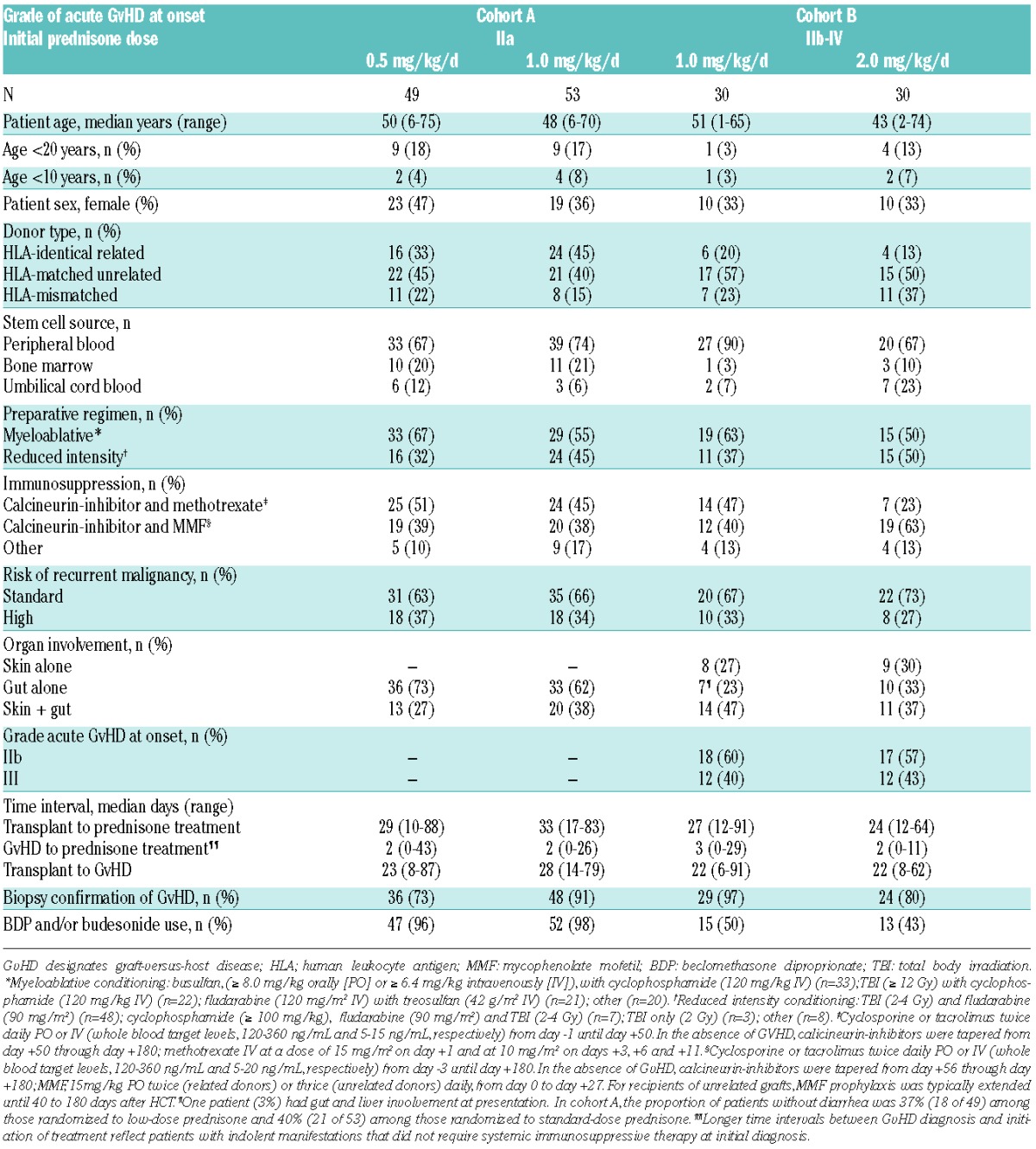
Stratification and randomization
Acute GvHD was diagnosed and graded according to estab lished criteria1,12 and patients were stratified into cohorts A and B according to severity of GvHD at symptom onset.
Cohort A: upper gastrointestinal symptoms of anorexia, nausea, vomiting attributed to acute GvHD, with stool volumes <1 L/day, rash involving <50% of the body surface, and no hepatic dysfunction.
Cohort B: rash involving ≥50% of the body surface, stool volumes ≥1 L/day or hepatic involvement with total serum bilirubin > 2 mg/dL.
Biopsy confirmation of the diagnosis was encouraged but not required. Patients with grade IIa manifestations11 (cohort A) were randomized to start therapy with a prednisone-equivalent dose of either 1 or 0.5 mg/kg/day. Those with grade IIb or higher manifestations11 (cohort B)) were randomized to start treatment with a prednisone-equivalent dose of either 2 or 1 mg/kg/day. Randomization was further stratified according to risk of recurrent malignancy (standard vs. high) and pre-transplant comorbidity (hematopoietic cell transplant comorbidity index: 0–1 vs. ≥2).13
Statistical analysis
Primary end point: the primary end point of the study was a 33% or more reduction of the mean cumulative prednisone dose by day 42 of treatment among patients initially treated with a prednisone dose of 0.5 mg/kg/day in cohort A and a dose of 1 mg/kg/day in cohort B compared to those given standard-dose prednisone. We estimated a 3:2 enrollment ratio for patients presenting with grade IIa manifestations (cohort A) versus those presenting with grade IIb or higher manifestations (cohort B). Planned enrollment of 150 patients provided 93% and 98% power in the two strata, respectively, to detect a true 33% reduction in mean cumulative day 42 dose, at the one-sided 0.025 level of significance.
Secondary end points: given concern that a lower initial dose of prednisone (0.5 mg/kg/day in cohort A and 1 mg/kg/day in cohort B) may lead to worse outcomes, overall mortality (“harm”) at one year after the initiation of therapy was evaluated in both cohorts. The cumulative incidences of progression to grades III–IV acute GvHD and secondary systemic therapy for acute GvHD by one year after enrollment were also assessed. Infections, hyperglycemia, hypertension, myopathy and quality-of-life were compared as indicators of prednisone toxicity. Further details regarding statistical considerations pertaining to the secondary end points are provided in the Online Supplementary Appendix.
Results
Patients enrolled
Between May 2009 and June 2013, the study enrolled 164 patients. Two patients were randomized within the incorrect stratum and were allocated to doses for which they were not eligible, leaving 162 evaluable patients (cohort A, n=102; cohort B, n=60). Most demographic and transplant characteristics were balanced between patients enrolled in the two prednisone-dose arms in cohort A and cohort B, respectively (Table 1). Clinical characteristics of patients enrolled in the study were compared with those of eligible patients who were not enrolled (Online Supplementary Table S2) and showed no evidence of bias toward selective enrollment of patients with less severe GvHD.
Figure 1.
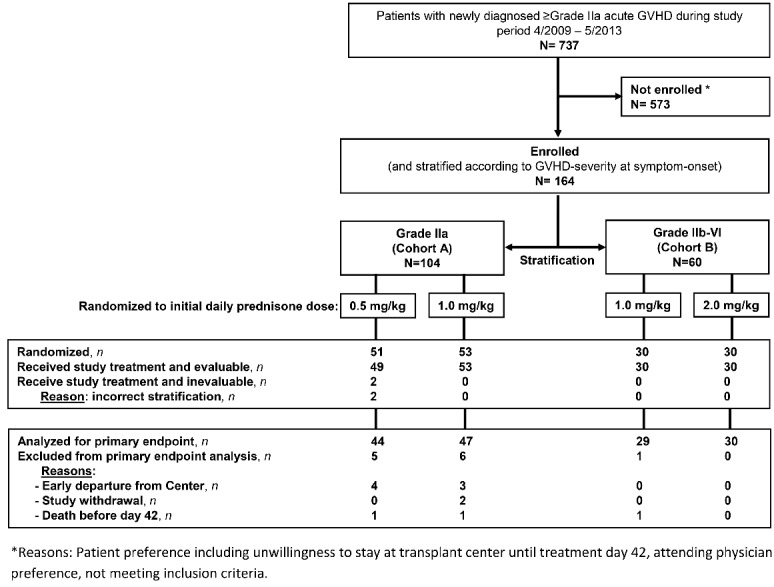
Stratification and randomization. During the enrollment period for the study from April 2009 to May 2013, 737 patients were newly diagnosed with ≥ grade IIa acute GvHD. One hundred and sixty-four patients (22%) were enrolled and stratified according to severity of manifestations at symptom onset. Patients in cohort A with grade IIa-manifestations (upper gastrointestinal symptoms of anorexia, nausea, vomiting attributed to acute GvHD, with stool volumes < 1 L/day, rash involving < 50% of the body surface, and no hepatic dysfunction) were randomized to start GvHD-therapy with a prednisone-equivalent dose of either 1 or 0.5 mg/kg/day. Those in cohort B with ≥grade IIb-manifestations (rash involving ≥ 50% of the body surface, stool volumes ≥ 1 L/day or hepatic involvement with total serum bilirubin > 2 mg/dL) were randomized to start treatment with a prednisone-equivalent dose of either 2 or 1 mg/kg/day. Randomization was further stratified on recurrence risks of underlying malignancies (standard vs. high) and pre-transplant comorbidity (hematopoietic cell transplant comorbidity index, 0–1 vs. ≥ 2). Two patients were randomized within the incorrect stratum and were allocated to doses for which they were not eligible, leaving 162 patients (grade IIa manifestations, n=102; ≥grade IIb-manifestations, n=60) who initiated prednisone treatment according to study. Twelve patients could not be included in the analysis of the primary end point (departure from Center before treatment day 42, n=7; study withdrawal, n=2; death before treatment day 42, n=3).
Primary end point: mean cumulative prednisone dose at day 42 of treatment
Cumulative prednisone dose was determined among 150 patients treated with prednisone for 42 days. Twelve patients discontinued prednisone before day 42 because of early departure from the Center (n=7), death (n=3) or withdrawal from study (n=2). For patients in cohort A treated initially with either 1 or 0.5 mg/kg/day, the mean ±SD cumulative prednisone doses were 27.1±12.7 versus 22.2±13.7 mg/kg, respectively, at day 42 (18% reduction; P=0.08). For patients in cohort B treated initially with either 2 or 1 mg/kg/day, mean ±SD cumulative prednisone doses were 41.3±12.1 versus 38.4±14.1 mg/kg (7% reduction; P=0.4) (Figure 2).
Figure 2.
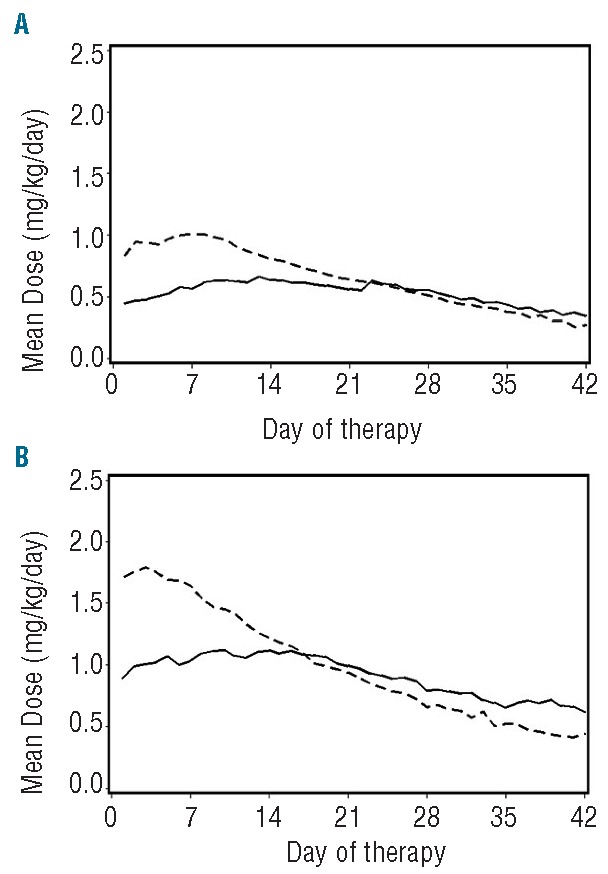
Primary end point: prednisone use according to initial dose and GvHD-grade at onset of symptoms. (A) Patients who presented with Grade IIa-manifestations (cohort A; n=91); initial prednisone dose, 0.5 mg/kg/day (solid line) or 1 mg/kg/day (dashed line). (B) Patients who presented with ≥grade IIb-manifestations (cohort B; n=59); initial prednisone dose, 1 mg/kg/day (solid line) or 2 mg/kg/day (dashed line). The graphs show mean prednisone doses per day until day 42 after starting treatment. Only patients who completed 42 days of prednisone treatment were included in the cumulative dose analysis (n=150).
Pre-specified secondary “no harm” end points
Overall survival, progression to grade III–IV acute GvHD and secondary systemic immunosuppressive therapy: in comparison between the aggregated standard-dose groups (1 mg/kg/day for cohort A; 2 mg/kg/day for cohort B) and the aggregated lower dose groups (0.5 mg/kg/day for cohort A; 1 mg/kg/day for cohort B), no statistically significant differences were observed in the likelihood of overall survival [77% (95%CI: 67%–86%) vs. 77% (95%CI: 67%–86%); HR 1.02 (95%CI: 0.6%–1.74%); P=0.95] (Figure 3A–C) and progression to grade III–IV acute GvHD [13% (95%CI: 7%–23%) vs. 6% (95%CI: 2%–14%); HR 0.43 (95%CI: 0.14%–1.33%)].
Figure 3.
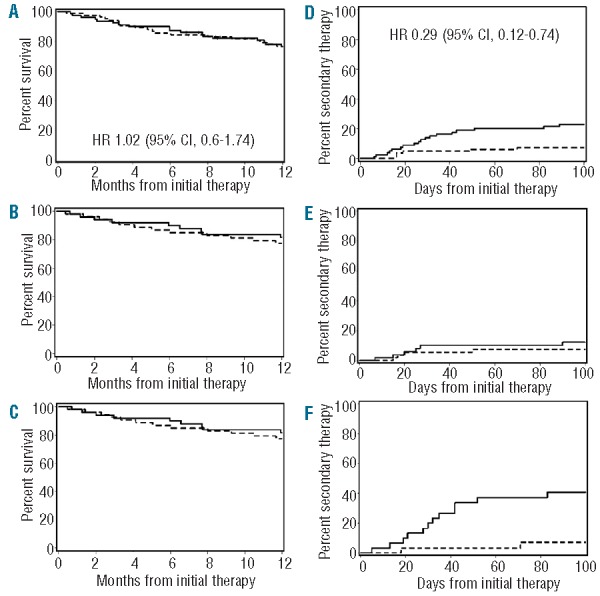
Pre-specified secondary “no harm” end points according to initial treatment with lower-dose or higher-dose prednisone. (A) Kaplan-Meier estimates of overall survival after initiation of prednisone therapy among all patients, (B) among those in cohort A, and (C) among those in cohort B. (D) Cumulative incidence of non-prednisone secondary systemic immunosuppressive therapy after initiation of prednisone therapy among all patients, (E) among those in cohort A, and (F) among those in cohort B. Secondary systemic immunosuppressive therapy in cohort B included mycophenolate mofetil (n=6), ATG (n=3), sirolimus (n=2), alemtuzumab (n=1), or etanercept (n=1). Solid line: patients who started treatment with lower-dose prednisone (0.5 mg/kg/day or 1 mg/kg/day for those in cohorts A and B, respectively). Dashed line: patients who started treatment with higher-dose prednisone (1 mg/kg/day or 2 mg/kg/day for those in cohorts A and B, respectively).
Among patients in cohort A (n=102), the likelihood of progression to grade III–IV acute GvHD was 10% among patients who started treatment with a prednisone dose of 0.5 mg/kg/day and 6% among those who started treatment with a dose of 1 mg/kg/day (P=0.39). Among patients in cohort B who presented with grade IIb acute GvHD (n=53), the likelihood of progression to grade III–IV acute GvHD was 19% among patients who started treatment with a prednisone dose of 1 mg/kg/day and 7% among those who started treatment with a dose of 2 mg/kg/day (P=0.20).
The risk of requiring secondary systemic immunosuppressive therapy was significantly lower in the aggregated standard-dose groups compared to the aggregated lower dose groups [7% (95%CI: 2%–13%) vs. 23% (95%CI: 14%–32%); HR 0.29 (95%CI: 0.12%–0.74%); P=0.009] (Figure 3D). Further analysis showed that 9 of 102 patients (9%) in cohort A required secondary systemic immunosuppressive therapy. Among patients in cohort A, initial prednisone dose was not associated with the likelihood of requiring secondary systemic immunosuppressive therapy (12% vs. 8%; P=0.44) (Figure 3E). In comparison, 13 of 60 patients (22%) in cohort B required secondary systemic immunosuppressive therapy. Among patients in cohort B, initial treatment with a prednisone of 1 mg/kg/day was associated with an increased risk of requiring secondary systemic immunosuppressive therapy (41% vs. 7%; P=0.001) (Figure 3F). Secondary systemic immunosuppressive therapy in cohort B included mycophenolate mofetil (n=6), ATG (n=3), sirolimus (n=2), alemtuzumab (n=1), or etanercept (n=1).
Pre-specified measures of prednisone toxicity
Assessment of invasive infections, control of hyperglycemia and hypertension, degree of myopathy and quality-of-life at weekly intervals during the first 42 days after starting treatment showed no statistically significant associations with initial prednisone dose (Online Supplementary Table S1 and Online Supplementary Figure S1).
Exploratory secondary “no harm” end points
Non-relapse mortality, recurrent malignancy and chronic GvHD: in comparison between the aggregated standard-dose groups and the aggregated lower dose groups, no statistically significant differences were observed in the risks of NRM (16% vs. 15%), recurrent malignancy (21% vs. 21%) and chronic GvHD (54% vs. 47%) at 12 months after start of therapy (Figure 4). The risks of NRM (24% vs. 25%) at 12 months were also similar in the two prednisone-dose arms of cohort B (n=60) (Figure 4B and C).
Figure 4.
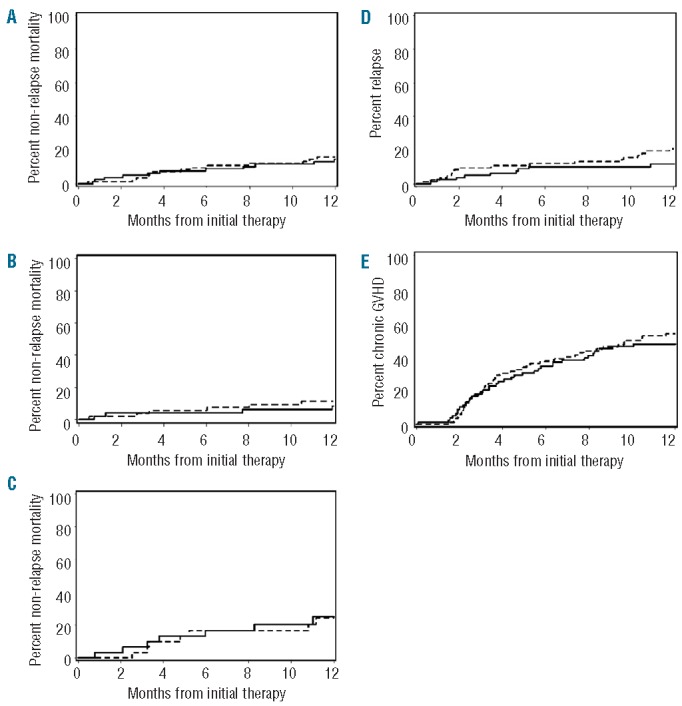
Additional secondary “no harm” end points according to initial treatment with lower-dose or higher-dose prednisone. (A) Cumulative incidence of non-relapse mortality among all patients, (B) among those in cohort A, and (C) among those in cohort B after initiation of prednisone therapy. (D) Cumulative incidence of relapse and (E) chronic GvHD requiring systemic immunosuppressive therapy among all patients after initiation of prednisone therapy. Solid line: patients who started treatment with lower-dose prednisone (0.5 mg/kg/day or 1 mg/kg/day for those in cohorts A and B, respectively). Dashed line: patients who started treatment with higher-dose prednisone (1 mg/kg/day or 2 mg/kg/day for those in cohorts A and B, respectively).
Additional exploratory analyses
Among patients in cohort B, an exploratory analysis suggested that skin-predominant GvHD (rash involving >50% of body surface) at onset was associated with a higher likelihood of requiring secondary immunosuppressive therapy after initial treatment with a prednisone dose of 1 mg/kg/day (53% vs. 18%; P=0.06). In contrast, gut-predominant GvHD at onset (stool volume >1.0 L/24 h) was not associated with the risk of requiring secondary immunosuppressive therapy in this cohort (43% vs. 39%; P=0.86).
Discussion
Since the clinically most meaningful measure of prednisone-associated morbidity in hematopoietic allograft recipients is unknown, a 33% or greater reduction in mean prednisone exposure by treatment day 42 among patients started on the lower dose was chosen as a surrogate primary end point for this study. The secondary end points were included to rule out evidence of egregious harm and to estimate the possible effect size of any favorable differences for the low-dose regimen before undertaking an adequately powered follow-up study given the expectation that the current study would show a large reduction in cumulative prednisone exposure. The primary end point of the study was not reached. The unexpectedly smaller reductions in prednisone exposure during the first 42 days of treatment between the two arms of each cohort reflected an evolving practice of rapid prednisone withdrawal in responding patients who were initially given the higher doses. Importantly, they did not reflect prednisone dose-escalations related to treatment-failure in patients who started treatment at the lower doses (Figure 2).
The results of our study are nevertheless consistent with results of the prior retrospective study9 suggesting that newly diagnosed acute GvHD in most patients can be managed effectively and safely by initiating treatment with prednisone at doses below the current standard of care. For patients presenting with grade IIa acute GvHD (cohort A), initial treatment with prednisone at 0.5 mg/kg/day (instead of 1 mg/kg/day) was safe and effective. For patients presenting with grade IIb or higher symptoms (cohort B), initial treatment with a prednisone dose of 1 mg/kg/day (instead of 2 mg/kg/day) was associated with an increased likelihood of requiring secondary immunosuppressive therapy. Although the study was not powered to detect mortality differences, results showed no suggestion that use of the lower dose adversely affected survival. No patient enrolled in the study or diagnosed with acute GvHD during the study period had grade IV symptoms at the time of initial presentation.
Larger differences in day 42 prednisone exposure might have emerged between the two arms if the protocol had specified a schedule for tapering the prednisone dose. The option of making dose adjustments according to perceived clinical response greatly facilitated the willingness of physicians and patients to participate in the study by reducing concerns about over- or undertreatment. This flexibility had the advantage of more accurately matching clinical practice, where dose adjustments are made routinely according to response. Hence, our study design emphasized clinical effectiveness over clinical efficacy.
In patients who presented with mild to moderately severe symptoms (cohort A), initial treatment with a prednisone dose of 0.5 mg/kg/day was effective and did not compromise survival. Slightly greater proportions of patients initially treated with a prednisone dose of 0.5 mg/kg/day required secondary immunosuppressive therapy (12% vs. 8%) or progressed to severe GvHD (10% vs. 6%). Although the study was not powered to detect statistically significant differences in secondary “no harm” end points, these differences were statistically not significant. It is important to note that patients with gastrointestinal symptoms in this group were concomitantly treated with topical oral glucocorticoids (usually BDP and budesonide). It is, therefore, unclear whether initial treatment with a prednisone dose of 0.5 mg/kg/day would have been equally effective without concomitant use of oral topical glucocorticoids. Conversely, one could speculate that oral topical glucocorticoids alone might be sufficient initial therapy for patients who present with upper gastrointestinal symptoms, diarrhea volumes below 1.0 L/day and skin rash involving less than 50% of the body surface. This important question should be addressed in future studies.
Among patients who presented with grade IIb or higher GvHD (cohort B), initial treatment with the lower prednisone dose of 1 mg/kg/day was associated with an increased likelihood of requiring secondary systemic immunosuppressive therapy. Although survival did not appear to be adversely affected by use of lower-dose prednisone in this group, it is important to emphasize that the study was not powered to detect such differences. As a rule, prednisone doses were increased before starting non-prednisone secondary therapies in patients initially treated with prednisone at 1 mg/kg/day. The increased need for secondary immunosuppressive therapy per se among patients in this cohort who were randomized to a prednisone dose of 1 mg/kg/day should not be interpreted as a failure of the lower-dose treatment approach. One could argue that initial prednisone-sparing had to be compensated with non-prednisone immunosuppression at a later time, which did not have a measurable negative impact on outcome. Since cumulative prednisone use was recorded only until treatment day 42, it is unclear whether extended follow up might have shown reduced prednisone utilization among patients initially treated with standard-dose prednisone compared to those initially treated with lower dose prednisone.
Additional exploratory analyses suggested that patients in cohort B who had skin-predominant symptoms were more likely to require secondary systemic immunosuppressive therapy than those who had gut-predominant symptoms. This finding was unexpected and suggests that GvHD in the two target organs might have differential sensitivity to prednisone. Organ-specific susceptibility to prednisone could be related to differential prednisone-sensitivity of resident donor effector cells. Pro-inflammatory human Th17 cells, for example, are refractory to glucocorticoids,14 although it is unknown whether these cells are more abundant in the skin than in gastrointestinal mucosa in patients with GvHD.
The expectation that prednisone-associated toxicity could be reduced without causing harm was an important motivation for conducting this trial. The lack of differences in toxicity profiles between patients treated with lower dose prednisone versus those treated with higher-dose prednisone can be explained by the absence of major differences in prednisone exposure during the initial 42 days of treatment (prednisone exposure difference ≤18%). The rate of prednisone withdrawal was not dictated by the protocol, an approach that facilitated enrollment in the study. Clinical practice at our institution has evolved toward accelerated withdrawal of prednisone in patients with GvHD manifestations responding to initial treatment at higher doses, which reduced differences in cumulative prednisone exposure. Other institutions might not follow a similarly rapid prednisone taper schema. If so, initial GvHD treatment at lower prednisone doses could prevent toxicity more effectively than observed in our trial. Finally, since our study did not include patients presenting with grade I acute GvHD (rash involving <50% of the body surface without liver or gut involvement), our findings cannot be extrapolated to these patients. As illustrated by our comparison with patients who were not enrolled in the study, factors beyond clinical grade such as progression kinetics or appearance of a rash clearly affect treatment decisions. Overall, the estimated effect sizes and confidence intervals for secondary end points in this study were too small to justify further trials designed to demonstrate statistically significant advantages for the lower-dose regimen, and the medical considerations are not of sufficient importance to justify further trials designed to demonstrate non-inferiority of the lower-dose regimen.
Results of this study, and the previous retrospective study, have important practice implications. When gastrointestinal manifestations of GvHD are present, our findings apply only when topical oral glucocorticoids are given in addition to systemic glucocorticoids. For patients who present with grade IIa acute GvHD manifestations (“upper gut syndrome”), initial treatment with a prednisone-equivalent dose of 0.5 mg/kg/day is safe and effective. For patients who present with grade IIb or higher manifestations, initial treatment with a prednisone-equivalent dose of 1 mg/kg/day is associated with an increased likelihood of requiring secondary immunosuppressive therapy without an apparent negative impact on survival. Whether the risk of requiring secondary immunosuppressive therapy is confined to patients with skin-predominant disease, as suggested by our exploratory analysis, needs to be confirmed in future studies. Thus, for patients who present with grade IIb or higher manifestations, initial treatment with a dose of 2 mg/kg/day followed by a rapid taper should be considered, if the objective is to minimize the need for secondary immunosuppressive therapy. In addition, further validation of prognostic factors that could help identify a priori those patients at risk for fatal GvHD would be of great clinical importance.15–17 Whether initial therapy with regimens that are more immunosuppressive than prednisone alone would yield better outcomes in these patients is unknown and deserves further study.
Acknowledgments
We thank Helen Crawford for assistance with manuscript preparation, and Andrea Lieserowitz, DPT, and Lexi Harlow, DPT, for expert advice on comprehensive muscle strength evaluation. We are also grateful to the physicians, nurses, physician assistants, nurse practitioners, pharmacists, and support staff caring for our patients, and to the patients who participated in this study.
Footnotes
The online version of this article has a Supplementary Appendix.
Funding
The authors are grateful for research funding from the National Institutes of Health, Bethesda, MD grants HL108307 (M. Mielcarek), CA078902, CA018029 and CA015704. The funders had no role in study design, data collection and analysis, decision to publish, or preparation of the manuscript. The content is solely the responsibility of the authors and does not necessarily represent the official views of the National Institutes of Health or its subsidiary Institutes and Centers.
Authorship and Disclosures
Information on authorship, contributions, and financial & other disclosures was provided by the authors and is available with the online version of this article at www.haematologica.org.
References
- 1.Glucksberg H, Storb R, Fefer A, et al. Clinical manifestations of graft-versus-host disease in human recipients of marrow from HL-A-matched sibling donors. Transplantation. 1974;18(4):295–304. [DOI] [PubMed] [Google Scholar]
- 2.Weisdorf D, Haake R, Blazar B, et al. Treatment of moderate/severe acute graft-versus-host disease after allogeneic bone marrow transplantation: An analysis of clinical risk features and outcome. Blood. 1990;75(4):1024–1030. [PubMed] [Google Scholar]
- 3.Shlomchik WD. Graft-versus-host disease (Review). Nat Rev Immunol. 2007;7(5):340–352. [DOI] [PubMed] [Google Scholar]
- 4.Storb R, Deeg HJ, Whitehead J, et al. Methotrexate and cyclosporine compared with cyclosporine alone for prophylaxis of acute graft versus host disease after marrow transplantation for leukemia. N Engl J Med. 1986;314(12):729–735. [DOI] [PubMed] [Google Scholar]
- 5.Martin PJ, Schoch G, Fisher L, et al. A retrospective analysis of therapy for acute graft-versus-host disease: initial treatment. Blood. 1990;76(8):1464–1472. [PubMed] [Google Scholar]
- 6.Martin PJ, Schoch G, Fisher L, et al. A retrospective analysis of therapy for acute graft-versus-host disease: secondary treatment. Blood. 1991;77(8):1821–1828. [PubMed] [Google Scholar]
- 7.Antin JH, Chen AR, Couriel DR, Ho VT, Nash RA, Weisdorf D. Novel approaches to the therapy of steroid-resistant acute graft-versus-host disease. Biol Blood Marrow Transplant. 2004;10(10):655–668. [DOI] [PubMed] [Google Scholar]
- 8.van Lint MT, Uderzo C, Locasciulli A, et al. Early treatment of acute graft-versus-host disease with high- or low-dose 6-methyl-prednisolone: a multicenter randomized trial from the Italian Group for Bone Marrow Transplantation. Blood. 1998; 92(7):2288–2293. [PubMed] [Google Scholar]
- 9.Mielcarek M, Storer BE, Boeckh M, et al. Initial therapy of acute graft-versus-host disease with low-dose prednisone does not compromise patient outcomes. Blood. 2009;113(13):2888–2894. [DOI] [PMC free article] [PubMed] [Google Scholar]
- 10.McDonald GB, Bouvier M, Hockenbery DM, et al. Oral beclomethasone dipropionate for treatment of intestinal graft-versus-host disease: a randomized, controlled trial. Gastroenterology. 1998;115(1):28–35. [DOI] [PubMed] [Google Scholar]
- 11.Hockenbery DM, Cruickshank S, Rodell TC, et al. A randomized, placebo-controlled trial of oral beclomethasone dipropionate as a prednisone-sparing therapy for gastrointestinal graft-versus-host disease. Blood. 2007;109(10):4557–4563. [DOI] [PubMed] [Google Scholar]
- 12.Przepiorka D, Weisdorf D, Martin P, et al. 1994 Consensus Conference on Acute GVHD Grading. Bone Marrow Transplant. 1995;15(6):825–828. [PubMed] [Google Scholar]
- 13.Sorror ML, Maris MB, Storb R, et al. Hematopoietic cell transplantation (HCT)-specific comorbidity index: a new tool for risk assessment before allogeneic HCT. Blood. 2005;106(8):2912–2919. [DOI] [PMC free article] [PubMed] [Google Scholar]
- 14.Ramesh R, Kozhaya L, McKevitt K, et al. Pro-inflammatory human Th17 cells selectively express P-glycoprotein and are refractory to glucocorticoids. J Exp Med. 2014;211(1):89–104. [DOI] [PMC free article] [PubMed] [Google Scholar]
- 15.Rezvani AR, Storer BE, Storb RF, et al. Decreased serum albumin as a biomarker for severe acute graft-vs-host disease after reduced-intensity allogeneic hematopoietic cell transplantation. Biol Blood Marrow Transplant. 2011;17(11):1594–1601. [DOI] [PMC free article] [PubMed] [Google Scholar]
- 16.Vander Lugt MT, Braun TM, Hanash S, et al. ST2 as a marker for risk of therapy-resistant graft-versus-host disease and death. N Engl J Med. 2013;369(6):529–539. [DOI] [PMC free article] [PubMed] [Google Scholar]
- 17.Paczesny S, Krijanovski OI, Braun TM, et al. A biomarker panel for acute graft-versus-host disease. Blood. 2009;113(2):273–278. [DOI] [PMC free article] [PubMed] [Google Scholar]


